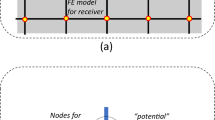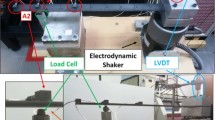Abstract
To validate models of contact mechanics in low speed structural impact, slender rods were impacted in a drop tower, and measurements of the contact and vibration were compared to analytical and finite element (FE) models. The contact area was recorded using a novel thin-film transfer technique, and the contact duration was measured using electrical continuity. Strain gages recorded the vibratory strain in one rod, and a laser Doppler vibrometer measured speed. The experiment was modeled analytically on a one-dimensional spatial domain using a quasi-static Hertzian contact law and a system of delay differential equations. The three-dimensional FE model used hexahedral elements, a penalty contact algorithm, and explicit time integration. A small submodel taken from the initial global FE model economically refined the analysis in the small contact region. Measured contact areas were within 6 % of both models’ predictions, peak speeds within 2 %, cyclic strains within 12 με (RMS value), and contact durations within 2 μs. The global FE model and the measurements revealed small disturbances, not predicted by the analytical model, believed to be caused by interactions of the non-planar stress wavefront with the rod’s ends. The accuracy of the predictions for this simple test, as well as the versatility of the diagnostic tools, validates the theoretical and computational models, corroborates instrument calibration, and establishes confidence that the same methods may be used in experimental and computational study of contact mechanics during impact of more complicated structures. Recommendations are made for applying the methods to a particular biomechanical problem: the edge-loading of a loose prosthetic hip joint which can lead to premature wear and prosthesis failure.












Similar content being viewed by others
References
Timoshenko SP, Goodier JN (1970) Theory of elasticity, 3rd edn. McGraw Hill, New York
Thomson WT (1960) Laplace transformation. Prentice Hall, Englewood Cliffs
Goldsmith W (1960) Impact: The theory and physical behaviour of colliding solids. Edward Arnold, Ltd., London
Guo A, Batzer S (2004) Substructure analysis of a flexible system contact-impact event. J Vib Acoust 126(1):126–131
Marghitu DB, Boghiu D (1996) Spatial impact of a flexible link using a nonlinear contact force. In: ASME International Mechanical Engineering Congress, Atlanta, 1996. American Society of Mechanical Engineers, Design Engineering Division (Publication) DE. ASME, New York, NY, USA, pp 103–110
Schiehlen W, Seifried R (2004) Three approaches for elastodynamic contact in multibody systems. Multibody Sys Dyn 12(1):1–16
Trowbridge DA, Grady JE, Aiello RA (1991) Low velocity impact analysis with NASTRAN. Comput Struct 40(4):977–984
Seifried R, Hu B (2003) Numerical and experimental investigation of radial impacts on a half-circular plate. Multibody Sys Dyn 9(3):265–281
Wei H, Yida Z (1995) Finite element analysis on collision between two moving elastic bodies at low velocities. Comput Struct 57(3):379–382
Frew DJ, Forrestal MJ, Chen W (2002) Pulse shaping techniques for testing brittle materials with a split Hopkinson pressure bar. Exp Mech 42(1):93–106. doi:10.1177/0018512002042001794
Doyle JF (1997) Wavelet deconvolution method for impact force identification. Exp Mech 37(4):403–408
Yang IY, Im KH (1996) Impulsive stress analysis of plates at the concentrated impact loading point by the three-dimensional dynamic theory of elasticity. Exp Mech 36(4):421–429
Doyle JF (1987) Determining the contact force during the transverse impact of plates. Exp Mech 27(1):68–72
Hu B, Eberhard P (2004) Simulation of longitudinal impact waves using time delayed systems. J Dyn Syst Meas Control 126(3):644–649
Cormier NG, Smallwood BS, Sinclair GB et al (1999) Aggressive submodelling of stress concentrations. Int J Numer Methods Eng 46:889–909
Rajasekaran R, Nowell D (2005) On the finite element analysis of contacting bodies using submodelling. J Strain Anal Eng Des 40:95–106
Nevelos J, Ingham E, Doyle C et al (2000) Microseparation of the centers of alumina-alumina artificial hip joints during simulator testing produces clinically relevant wear rates and patterns. J Arthroplasty 15(6):793–795
Walter WL, Insley GM, Walter WK et al (2004) Edge loading in third generation alumina ceramic-on-ceramic bearings: stripe wear. J Arthroplasty 19(4):402–413
Kwon YM, Glyn-Jones S, Simpson DJ et al (2010) Analysis of wear of retrieved metal-on-metal hip resurfacing implants revised due to pseudotumours. J Bone Joint Surg Br 92(3):356–361
Sanders AP, Brannon RM (2011) Assessment of the applicability of the Hertzian contact theory to edge-loaded prosthetic hip bearings. J Biomech 44(16):2802–2808
Kreyszig E (1988) Advanced engineering mathematics, 6th edn. Wiley and Sons, New York
Drumheller DS (1998) Introduction to wave propagation in nonlinear fluids and solids. Cambridge University Press, Cambridge
Hu B, Schiehlen W, Eberhard P (2003) Comparison of analytical and experimental results for longitudinal impacts on elastic rods. J Vib Control 9(1–2):157–174
Johnson KL (1985) Contact mechanics. Cambridge University Press, Cambridge
Shampine LF, Reichelt MW (1997) The MATLAB ODE suite. SIAM J Sci Comput 18(1):1
Fischer-Cripps AC (2000) Introduction to contact mechanics. Mechanical engineering series. Springer, New York
Tech Note TN-514: Shunt calibration of strain gage instrumentation (2007) Vishay Micro-Measurements, Rayleigh, North Carolina
Sanders AP, Brannon RM (2011) Determining a surrogate contact pair in a Hertzian contact problem. J Tribol 133(2):024502–024506. doi:10.1115/1.4003492
Acknowledgments
This research was supported by the National Institutes of Health/NIAMS, Grant No. 1R21AR056374. The authors thank Jeff Kessler for laboratory assistance, particularly with the drop tower test machine.
Author information
Authors and Affiliations
Corresponding author
Rights and permissions
About this article
Cite this article
Sanders, A., Tibbitts, I., Kakarla, D. et al. Contact-Coupled Impact of Slender Rods: Analysis and Experimental Validation. Exp Mech 54, 187–198 (2014). https://doi.org/10.1007/s11340-013-9778-6
Received:
Accepted:
Published:
Issue Date:
DOI: https://doi.org/10.1007/s11340-013-9778-6




